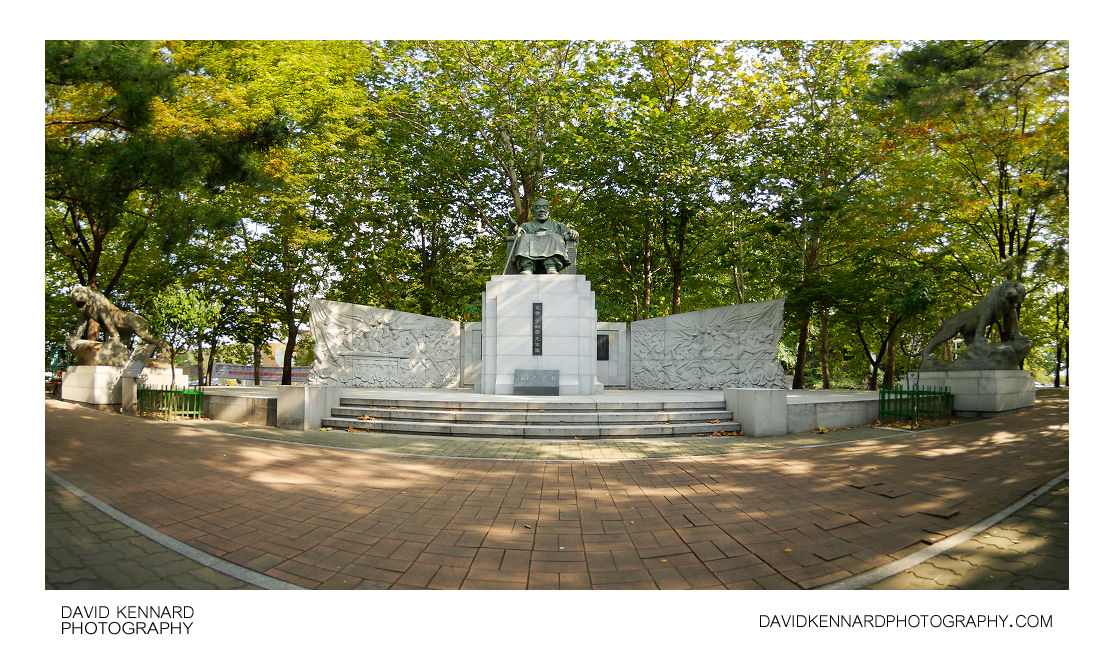Seongjae Lee Si-Yeong Statue

Description
- Title:
- Seongjae Lee Si-Yeong Statue
- Caption / Description:
-
The memorial to Seongjae Lee Si-Yeong (성재 이시영선생) in Baekbeom Square (백범광장), Namsan Park (남산공원), Seoul (서울).
Born in 1869, Seongjae Lee Si-Yeong achieved academic success at a relatively early age. He soon became a government official, filling posts such as the Negotiation Bureau Director, the chief of Hanseong Court (한성법정), and the governor of Pyeongannam-do (평안 남도).
When the Japan–Korea Annexation Treaty was signed in 1910, making the Japanese rule of Korea official, Lee Si-Yeong fled to China, along with 40 family members. In China he set up the Gyeonghaksa (경학사) and Shinheung (신흥) military school, to educate and recruit Independence Army fighters. It was troops trained by Si-Yeong's school who greatly contributed to the Korean Independence Army's victory over the Japanese at the battle of Cheongsanri (청산리).
Seongjae Lee Si-Yeong also helped set up the Korean Provional Government in Shanghai, in 1919. He served first as the Minister of Justice, and then as the Minister of Financial Affairs, until Korea's freedom from Japanese rule at the end of the Second World War, in 1945.
Lee returned to Korea, and in 1947 he founded the Seongjae Shinheung College (성재신흥대학) to continue the work he had started with his military school. The college has today grown into the Kyung Hee University (경희대학교).
In July 1948, he was elected Korea's first Vice President at the Constitutional Assembly. However, he protested against president Lee Seung-man's (이승만) (also known as Syngman Rhee) dictatorship, and resigned his position in May 1951.
Lee Si-Yeong died in Dongrae (동래), Busan (부산), where he had sheltered during the Korean War, on April 17 1953, at the age of 85. He is buried at his resting place in Suyudong (수유동).
- Tags / Keywords:
-
- Asia
- 한국
- Hanguk
- 韓國
- Jung-gu
- 중구
- 中區
- Korea
- Seoul Special City
- Seoul Teukbyeolsi
- 서울特別市
- 서울특별시
- Hoehyeon-dong
- 회현동
- 會賢洞
- Baekbeom Square
- 백범광장
- Namsan Park
- 남산공원
- 성재 이시영선생
- Seongjae Lee Si-Yeong
Admin
- Date Original Photo Taken:
- Original File Name:
- Seongjae Lee Si-Yeong Statue.psd
- Event:
- Rating:
- Date this image added/last updated on website:
- Original File Dimensions:
- 3827px x 2057px
- File Type:
- JPEG
- Color Mode:
- RGB
- Original Image Color Profile:
- Nikon Adobe RGB 4.0.0.3001
Location
- Location Shown:
-
- Sublocation:
- Baekbeom Square
- City:
- Jung-gu
- Province/State:
- Seoul
- Country:
- Korea, Republic Of
- World Region:
- Asia
- Location Created:
-
- Sublocation:
- Baekbeom Square
- City:
- Jung-gu
- Province/State:
- Seoul
- Country:
- Korea, Republic Of
- World Region:
- Asia
- Geo-location:
Rights
- Copyright Status:
- Copyrighted
- Licensing Status:
- Rights Managed
- Available for Editorial Use:
- Yes
- Available for Commercial Use:
- No
- Copyright Notice:
- © 2009 Dave Kennard
Camera Data
- Date Digital Resource was created:
- Shutter speed:
- 1⁄90 s
- Aperture:
- f/4
- Camera Model:
- Nikon D200
- ISO:
- 100
- Exposure Compensation:
- 0
- Focal Length:
- 10mm
- Focal Length (35mm equiv.):
- 15mm
- Metering Mode:
- Multi-segment
- Flash:
- No Flash
- Exposure Mode:
- Auto
- White Balance:
- Manual
- Light Source:
- Cloudy
- Exposure Program:
- Aperture-priority AE
Additional shooting metadata
- Lens:
- Tokina ATX107 DX FishEye 10-17mm F3.5-4.5
- Filters used:
- Additional Optics used:
- Setup:
- Handheld, bracketed ±1EV
Post Processing
- Image Modified:
- Software used:
-
- Adobe Photoshop CS4
- PTGUI 8 Pro
- Nikon Capture NX 2
- Post Processing:
NEFs converted in Capture NX 2
Images blended in Photoshop CS4
Straightened in Photoshop CS4
Purple Fringing desaturated in Photoshop CS4
Curves adjustment to boost contrast in Photoshop CS4
Defished to equirectangular projection in PTGUI 8 Pro
Highpass sharpen in Photoshop CS4
